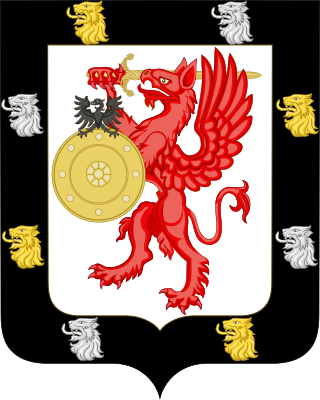
The House of Romanov was the reigning imperial house of Russia from 1613 to 1917. They achieved prominence after Anastasia Romanovna married Ivan the Terrible, the first crowned tsar of all Russia. Nicholas II, the last Emperor of Russia, and his immediate family were executed in 1918, but there are still living descendants of other members of the imperial house.

Alexandra Feodorovna, born Princess Alix of Hesse and by Rhine, was the last Empress of Russia as the consort of Tsar Nicholas II from their marriage on 26 November [O.S. 14 November] 1894 until his forced abdication on 15 March [O.S. 2 March] 1917. A granddaughter of Queen Victoria, Alexandra was one of the most famous royal carriers of hemophilia and passed the condition to her son, Alexei Nikolaevich, Tsarevich of Russia.

Grand Duchess Tatiana Nikolaevna of Russia was the second daughter of Tsar Nicholas II, the last monarch of Russia, and of Tsarina Alexandra. She was born at Peterhof Palace, near Saint Petersburg.

Grand Duchess Anastasia Nikolaevna of Russia was the youngest daughter of Tsar Nicholas II, the last sovereign of Imperial Russia, and his wife, Tsarina Alexandra Feodorovna.

Anna Anderson was an impostor who claimed to be Grand Duchess Anastasia of Russia. Anastasia, the youngest daughter of the last Tsar and Tsarina of Russia, Nicholas II and Alexandra, was murdered along with her parents and siblings on 17 July 1918 by Bolshevik revolutionaries in Yekaterinburg, Russia, but the location of her body was unknown until 2007.
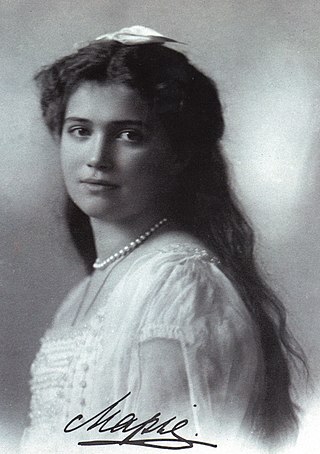
Grand Duchess Maria Nikolaevna of Russia was the third daughter of Tsar Nicholas II of Russia and Tsarina Alexandra Feodorovna. Her murder following the Russian Revolution of 1917 resulted in her canonization as a passion bearer by the Russian Orthodox Church.

Nikolai Dante was a comic book series published in the weekly British science fiction anthology 2000 AD from March 1997 until July 2012.
Zakhary Ivanovich Koshkin was a boyar at the court of Vasili II. He was a male-line forefather of the Romanov family, and the first Romanov Tsar, Michael I of Russia, was his agnatic descendant.

Princess Anastasia Petrović-Njegoš of Montenegro was the daughter of King Nikola I Petrović-Njegoš of Montenegro (1841–1921) and his wife, Queen Milena (1847–1923). Through her second marriage, she became Grand Duchess Anastasia Nikolaevna Romanova of Russia. She and her sister "Militza", having married Russian royal brothers, were known colloquially as the "Montenegrin princesses" during the last days of Imperial Russia, and may have contributed to its downfall by the introduction of Grigori Rasputin to the Empress Alexandra.

The Feodorovskaya Icon of the Mother of God, also known as Our Lady of Saint Theodore and the Black Virgin Mary of Russia, is the patron icon of the Romanov family. It is one of the most venerated icons in the Upper Volga region. Her feast days are March 14 (27) and August 29.

Princess Helen of Serbia was a Serbian princess. She was the daughter of King Peter I of Serbia and his wife, the former Princess Ljubica of Montenegro. She was the elder sister of George, Crown Prince of Serbia and King Alexander I of Yugoslavia. Helen was also a niece of Queen Elena of Italy, Princess Anastasia of Montenegro, wife of Grand Duke Nicholas Nikolaevich of Russia and of Princess Milica of Montenegro, wife of Grand Duke Peter Nikolaevich of Russia, the women who introduced Grigori Rasputin to Tsarina Alexandra.
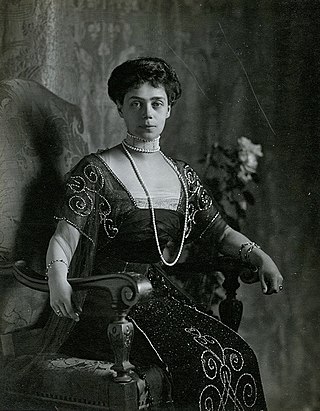
Grand Duchess Xenia Alexandrovna of Russia was the elder daughter and fourth child of Tsar Alexander III of Russia and Dagmar of Denmark. She was the sister of the last Emperor of Russia, Nicholas II.

The canonization of the Romanovs was the elevation to sainthood of the last Imperial Family of Russia – Tsar Nicholas II, his wife Tsarina Alexandra, and their five children Olga, Tatiana, Maria, Anastasia, and Alexei – by the Russian Orthodox Church.
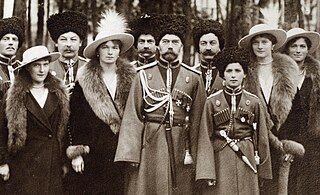
Members of the ruling Russian imperial family, the House of Romanov, were executed by a firing squad led by Yakov Yurovsky in Yekaterinburg, Russia, on July 17, 1918, during both the Russian Civil War and near the end of the First World War.

Anastasia: The Mystery of Anna is a 1986 American-Austrian-Italian made-for-television biographical film directed by Marvin J. Chomsky, starring Amy Irving, Rex Harrison, Olivia de Havilland, Omar Sharif, Christian Bale and Jan Niklas. The film was loosely based on the story of Grand Duchess Anastasia Nikolaevna of Russia and the book The Riddle of Anna Anderson by Peter Kurth. It was originally broadcast in two parts.
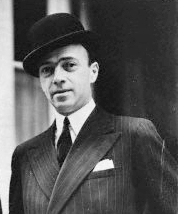
Prince Dmitri Alexandrovich of Russia was the fourth son and fifth child of Grand Duke Alexander Mikhailovich of Russia and Grand Duchess Xenia Alexandrovna of Russia. He was a nephew of Tsar Nicholas II of Russia.

The Romanovs: An Imperial Family is a 2000 Russian historical drama film about the last days of Tsar Nicholas II and his family. The Russian title implies both the Imperial Crown of Russia and the crown of thorns associated with martyrs. The film premiered at the 22nd annual Moscow Film Festival. The film was selected as the Russian entry for the Best Foreign Language Film at the 76th Academy Awards, but it didn't make the final shortlist.

The coronation of the emperor of Russia from 1547 to 1917, was a highly developed religious ceremony in which they are crowned and invested with regalia, then anointed with chrism and formally blessed by the church to commence his reign. Although rulers of Muscovy had been crowned prior to the reign of Ivan III, their coronation rituals assumed overt Byzantine overtones as the result of the influence of Ivan's wife Sophia Paleologue, and the imperial ambitions of his grandson, Ivan the Terrible. The modern coronation, introducing "Western European-style" elements, replaced the previous "crowning" ceremony and was first used for Catherine I in 1724. Since tsarist Russia claimed to be the "Third Rome" and the replacement of Byzantium as the true Christian state, the Russian rite was designed to link its rulers and prerogatives to those of the so-called "Second Rome" (Constantinople).

Nicholas II or Nikolai II was the last reigning Emperor of Russia, King of Congress Poland, and Grand Duke of Finland from 1 November 1894 until his abdication on 15 March 1917. He married Alix of Hesse in 1894 and had children Olga (1895), Tatiana (1897), Maria (1899), Anastasia (1901) and the tsarevich Alexei Nikolaevich.

The Russian Imperial Romanov family were shot and bayoneted to death by Bolshevik revolutionaries under Yakov Yurovsky on the orders of the Ural Regional Soviet in Yekaterinburg on the night of 16–17 July 1918. Also murdered that night were members of the imperial entourage who had accompanied them: court physician Eugene Botkin; lady-in-waiting Anna Demidova; footman Alexei Trupp; and head cook Ivan Kharitonov. The bodies were taken to the Koptyaki forest, where they were stripped, mutilated with grenades to prevent identification, and buried.



















